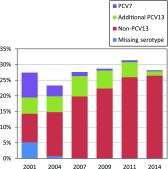Immunization, Antibiotic Use, and Pneumococcal Colonization Over a 15-Year Period
- PMID: 28978716
- PMCID: PMC5654389
- DOI: 10.1542/peds.2017-0001
Immunization, Antibiotic Use, and Pneumococcal Colonization Over a 15-Year Period
Abstract
Background: Rates of invasive pneumococcal disease have declined since widespread introduction of pneumococcal conjugate vaccines (PCVs) in the United States. We evaluated the impact of immunization status and recent antibiotic use on an individual child's risk of colonization.
Methods: This study extends previously reported data from children <7 years of age seen for well child or acute care visits in Massachusetts communities. Nasopharyngeal swabs were collected during 6 surveillance seasons from 2000 to 2014. Parent surveys and medical record reviews confirmed immunization status and recent antibiotic use. We estimated the proportions of children colonized with PCV7-included, additional PCV13-included, and non-PCV13 serotypes. Risk factors for colonization with additional PCV13-included and non-PCV13 serotypes were assessed by using generalized linear mixed models adjusted for clustering by community.
Results: Among 6537 children, 19A emerged as the predominant serotype in 2004, with substantial reductions in 2014. Among non-PCV serotypes, 15B/C, 35B, 23B, 11A, and 23A were most common in 2014. We observed greater odds for both additional PCV13 and non-PCV13 colonization in younger children, those with more child care exposure, and those with a concomitant respiratory tract infection. Adjusted odds for additional PCV13 colonization was lower (odds ratio 0.48 [95% confidence interval 0.31-0.75]) among children up-to-date for PCV13 vaccines. Recent antibiotic use was associated with higher odds of additional PCV13 colonization but substantially lower odds of non-PCV13 colonization.
Conclusions: Despite the success of pneumococcal vaccines in reducing colonization and disease due to targeted serotypes, ongoing community-based surveillance will be critical to evaluate the impact of interventions on pneumococcal colonization and disease.
Copyright © 2017 by the American Academy of Pediatrics.
Conflict of interest statement
POTENTIAL CONFLICT OF INTEREST: Dr Lipsitch has received consulting fees from Pfizer, Antigen Discovery, and Affinivax and has received research funding through his institution from Pfizer and PATH Vaccine Solutions. Dr Hanage has received consulting fees from Antigen Discovery. Ms Huang conducts clinical studies in which participating hospitals and nursing homes receive contributed products from Sage Products, Molnlycke, 3M, Clorox, and Xttrium. Dr Kleinman conducts trials in which participating hospitals and nursing homes receive contributed products from Sage Products and Clorox. Dr Pelton received honorarium for participation in scientific advisory boards from Pfizer, GlaxoSmithKline, Sequiris, and Merck as well as research funding to Boston University Medical Campus from Pfizer and Merck; the other authors have indicated they have no potential conflicts of interest to disclose.
Figures



Comment in
-
Playing "Whack-a-Mole" With Pneumococcal Serotype Eradication.Pediatrics. 2017 Nov;140(5):e20172034. doi: 10.1542/peds.2017-2034. Epub 2017 Oct 4. Pediatrics. 2017. PMID: 28978717 No abstract available.
References
-
- Byington CL, Samore MH, Stoddard GJ, et al. . Temporal trends of invasive disease due to Streptococcus pneumoniae among children in the intermountain west: emergence of nonvaccine serogroups. Clin Infect Dis. 2005;41(1):21–29 - PubMed
-
- Pilishvili T, Lexau C, Farley MM, et al. ; Active Bacterial Core Surveillance/Emerging Infections Program Network . Sustained reductions in invasive pneumococcal disease in the era of conjugate vaccine. J Infect Dis. 2010;201(1):32–41 - PubMed
-
- Pulido M, Sorvillo F. Declining invasive pneumococcal disease mortality in the United States, 1990-2005. Vaccine. 2010;28(4):889–892 - PubMed
-
- Centers for Disease Control and Prevention (CDC) Pneumonia hospitalizations among young children before and after introduction of pneumococcal conjugate vaccine–United States, 1997-2006. MMWR Morb Mortal Wkly Rep. 2009;58(1):1–4 - PubMed
MeSH terms
Substances
Grants and funding
LinkOut - more resources
Full Text Sources
Other Literature Sources
Medical

